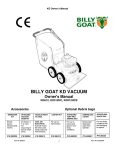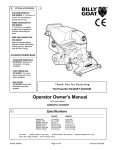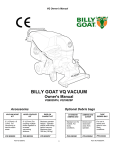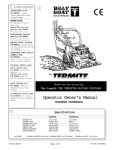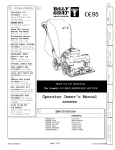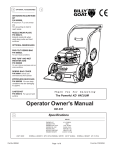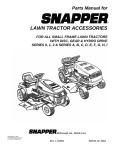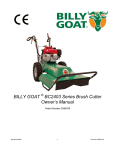Download Billy Goat KD512SP Yard Vacuum User Manual
Transcript
2
OPTIONAL ACCESSORIES
1
SHREDDER KIT
P/N 890209.
Shreds leaves, dramatically
reducing total volume, 12:1.
ON BOARD VACUUM
HOSE KIT
P/N 890041.
4"(102mm) x 7' (2.13m)
For vacuuming in hard to
reach areas.
HOSE EXTENSION KIT
P/N 890045.
Kit contains a connector and a
clamp, Hose is not included.
NOZZLE WEAR PLATES
P/N 890413.
Extends nozzle life when
used along curbs and hard
surfaces.
STANDARD TURF PRO
DEBRIS BAG
P/N 890028.
Standard on TKD models. For
use in leaves and grass in nondusty conditions.
OPTIONAL DEBRIS BAGS
PRO FELT BAG
P/N 890023
T h a n k Yo u f o r S e l e c t i n g
For use in dusty conditions.
FELT BAG COVER
P/N 900801
Directs dust downward away from
operator.
ZIPPERLESS PRO BAG
P/N 890309
The Powerful KD or TKD TERMITE®
SELF PROPELLED VACUUM CHIPPER
Operator Owner's Manual
For non dusty conditions that
are damaging to zippers.
KD512SP, TKD512SP
Specifications
3
ENGINE:H.P.
ENGINE:TYPE
ENGINE:FUEL CAP.
ENGINE:OIL CAP.
WEIGHT:UNIT
WEIGHT:SHIPPING
ENGINE WEIGHT:
UNIT SIZE:
Part No. 890604
KD512SP
5.5 (4.1kW)
B&S DIAMOND I/C
1.5qt. (1.4L)
0.63qt. (0.6L)
117# (53.1 kg)
140# (63.5 kg)
26# (11.8 kg)
TKD512SP
5.5 (4.1kW)
B&S DIAMOND I/C
1.5qt. (1.4L)
0.63qt. (0.6L)
133# (60.3 kg)
156# (70.8 kg)
26# (11.8 kg)
OVERALL LENGTH: 62"(1.57m) OVERALL WIDTH 26.75" (0.68m)
Page 1 of 12
OVERALL HEIGHT 42" (1.07m)
Form No. F021602C
5
IN THE INTEREST OF SAFETY
BEFORE STARTING ENGINE, READ AND UNDERSTAND THE “ENTIRE OPERATOR'S MANUAL &
ENGINE MANUAL.”
THIS SYMBOL MEANS WARNING OR CAUTION. DEATH, PERSONAL INJURY AND/OR PROPERTY
DAMAGE MAY OCCUR UNLESS INSTRUCTIONS ARE FOLLOWED CAREFULLY.
WARNING: The Engine Exhaust from this product contains chemicals known
to the State of California to cause cancer, birth defects or other reproductive harm.
13. DO NOT tamper with governor springs,
governor links or other parts which may
change the governed engine speed.
WARNING: DO NOT
1. DO NOT run engine in an enclosed area.
Exhaust gases contain carbon monoxide, an
odorless and deadly poison.
2. DO NOT place hands or feet near moving
or rotating parts.
3. DO NOT store, spill or use gasoline near
an open flame, or devices such as a stove,
furnace, or water heater which use a pilot
light or devices which can create a spark.
4. DO NOT refuel indoors where area is not
well ventilated. Outdoor refueling is recommended.
5. DO NOT fill fuel tank while engine is
running. Allow engine to cool for 2 minutes
before refueling. Store fuel in approved
safety containers.
6. DO NOT remove fuel tank cap while
engine is running.
8. DO NOT operate engine if gasoline is
spilled. Move machine away from the spill
and avoid creating any ignition until the
gasoline has evaporated.
9. DO NOT transport unit with fuel in tank.
10. DO NOT smoke when filling fuel tank.
11. DO NOT choke carburetor to stop
engine. Whenever possible, gradually
reduce engine speed before stopping.
6
TABLE OF CONTENTS
SAFETY INSTRUCTIONS
2
3
GENERAL SAFETY
3
ASSEMBLY
4
PARTS BAG & CONTROLS
LABELS
4
OPERATION
5-7
8-9
MAINTENANCE
PARTS DRAWING & LIST 10 - 12
TROUBLESHOOTING
12
WARRANTY PROCEDURE
12
○
○
○
○
○
○
○
○
○
○
○
○
○
○
○
○
○
18. DO NOT operate engine without a
muffler. Inspect periodically and replace, if
necessary. If engine is equipped with
muffler deflector, inspect periodically and
replace, if necessary, with correct deflector.
20. DO NOT use this engine on any forest
covered, brush covered, or grass covered
unimproved land unless a spark arrester is
installed on the muffler. The arrester must
be maintained in effective working order by
the operator. In the State of California the
above is required by law (Section 4442 of
the California Public Resources Code).
Other states may have similar laws.
Federal laws apply on federal lands.
25. DO NOT park machine on a steep grade
or slope.
WARNING: DO
1. ALWAYS DO remove the wire from the
spark plug when servicing the engine or
equipment TO PREVENT ACCIDENTAL
STARTING.
2. DO keep cylinder fins and governor
parts free of grass and other debris
which can affect engine speed.
3. DO pull starter cord slowly until resistance is felt. Then pull cord rapidly to avoid
kickback and prevent hand or
arm
injury.
4. DO examine muffler periodically to be
sure it is functioning effectively. A worn or
leaking muffler should be repaired or
replaced as necessary.
5. DO use fresh gasoline. Stale fuel can
gum carburetor and cause leakage.
6. DO check fuel lines and fittings frequently
for cracks or leaks. Replace if necessary
7. Follow engine manufacturer operating
and maintenance instructions.
8. Inspect machine and work area before
starting unit.
21. DO NOT touch hot muffler, cylinder, or
7
8
SOUND
Sound tests conducted were in accordance with 2000/14/EEC and
were performed on 2/16/2002 under the conditions listed:
NOTE: Sound power level listed is the highest value for any model in this manual.
Please refer to serial plate on the unit for the sound power level for your model.
Sound level of 96 dBA at operator position
GENERAL CONDITION:
Sunny
60° F (15.6° C)
TEMPERATURE:
○
○
○
17. DO NOT strike flywheel with a hard
object or metal tool as this may cause
flywheel to shatter in operation. Use proper
tools to service engine.
23. DO NOT operate during excessive
vibration!
24. DO NOT leave machine unattended
while in operation.
VIBRATION
VIBRATION LEVELS 2.2g
Vibration levels at the operators handles on model
TKD510SP were measured in the vertical, lateral, and
longitudinal directions using calibrated vibration test
equipment. Tests were performed on 05/19/95 under
the conditions listed:
GENERAL CONDITION:
Sunny
○
○
○
16. DO NOT crank engine with spark plug
removed. If engine is flooded, place throttle
in “FAST” position and crank until engine
starts.
22. DO NOT run engine without air cleaner
or air cleaner cover.
○
○
○
○
○
○
○
○
○
○
○
○
○
○
○
○
15. DO NOT check for spark with spark plug
or spark plug wire removed. Use an
approved tester.
19. DO NOT operate engine with an
accumulation of grass, leaves, dirt or other
combustible material in the muffler area.
7. DO NOT operate engine when smell of
gasoline is present or other explosive
conditions exist.
12. DO NOT run engine at excessive
speeds. This may result in injury & /or
damage to unit.
14. DO NOT tamper with the engine speed
selected by the engine manufacturer.
fins because contact may cause burns.
10 MPH (16.1 kmh)
WIND SPEED:
112 dB
North
WIND DIRECTION:
(TKD512SP MODEL)
32 %
HUMIDITY:
○
BAROMETRIC PRESSURE:
29.95" Hg (761mm Hg)
Part No. 890604
TEMPERATURE:
62° F (16.7° C)
WIND SPEED:
5 MPH (8.0 kmh)
WIND DIRECTION:
HUMIDITY:
BAROMETRIC PRESSURE:
South
67 %
30.06" Hg (764mm Hg)
Form No. F021602C
Page 2 of 12
9
GENERAL SAFETY
For your safety and the safety of others, these directions should be followed:
Do not operate this machine without first reading
owner's manual and engine manufacturer's manual.
Use of Ear Protection is recommended while
operating this machine.
Use of Eye and Breathing protection is recommended when using this machine, especially in dry
and dusty conditions. Optional bag cover directs dust
toward ground, away from the operator.
·DO NOT place hands or feet inside nozzle intake opening,
near debris outlet or near any moving parts.
·DO NOT start engine without debris bag and quick disconnect connected firmly in place to exhaust outlet.
·DO NOT start or operate machine with debris bag zipper
open.
10
ASSEMBLY
1. ASSEMBLE Lift upper handle (item 6), remove items 8, 73, 74, & 30
from lower handle (item 27). Attach upper and lower handle as shown,
and securely tighten folding handle knobs(item 73),while holding head of
screw(item 8) firmly against upper handle.
2. UNFOLD the debris bag (item 1) and fasten bag neck to bag quick
disconnect (item 83). Attach firmly to housing exhaust (item 52) see fig. 2.
3. ATTACH bag hanger strap to bag supports (item 11), preassembled to
upper handle.
4. INSTALL tamper (item 3) in chipper hopper (see page 7)(TKD ONLY).
5. CONNECT spark plug wire.
Read all safety and operating instructions
before assembling or starting this unit.
PUT OIL IN ENGINE BEFORE STARTING
Your Billy Goat is shipped from the factory in one carton,
completely assembled except for the upper handle, debris
bag, and bag quick disconnect.
11
·DO NOT operate during excessive vibration.
·DO NOT remove bag until engine has been turned off and has
come to a complete stop.
·DO NOT remove hose kit cap on nozzle until engine has been
turned off and has come to a complete stop.
·DO NOT operate machine with hose cap, bag or hose removed.
·DO NOT use this machine for vacuuming exclusively sand,
dust, fine dirt, rock, glass, string like material, grain, rags,
cans, metal, bark or water.
·DO NOT operate this machine on slopes greater than 20%.
·DO NOT pick up any hot or burning debris, or any toxic or
explosive material.
·DO NOT allow children to operate this equipment.
PACKING CHECKLIST
These items should be included in your carton. If
any of these parts are missing, contact your dealer.
1
Debris Bag
Check
890022 KD
Check
890028 TKD
Check
32
30
8
Connector
Quick Disconnect
890176
Check
Tamper
3
QUICK DISCONNECT
(TKD MODELS ONLY)
890229
64
Literature
Assembly
Engine
Manual
Check
Literature Assy
890594
Check
Briggs &
Stratton
Fig. 2
Part No. 890604
Page 3 of 12
Form No. F021602C
12
LITERATURE ASSY P/N 890594
Owner's
Manual
13
CONTROLS
Literature Checklist
Check
Owner's
Manual
Throttle
Control
890604
Literature
KD / TKD
Accessories
Warranty
Card
Check
Start
position
Literature
KD / TKD
Accessories
890409
Briggs
engines have
a primer
button
carburetor with
no choke.
Check
C
H
O
K
E
FAST
Warranty
Card 400972
SLOW
EU Declaration
of Conformity
& EU
Distributor List
14
Check
Stop
position
EU Declaration of
Conformity & EU
Distributor List
890393
15
INSTRUCTION LABELS
These labels should be included on your Vacuum. If any of these labels are
damaged, replace them before putting this equipment into operation. Item
and part numbers are given to help in ordering replacement labels..
Briggs & Stratton
WARNING
EXPLOSIVE FUEL
STOP ENGINE AND ALLOW TO
COOL BEFORE REFUELING.
WARNING
900327
810736
Label Danger
Guards
Item 84 Part No.
900327
Label Ear Eye
Breathing Item
No. 86 Part No.
890254
890254
DANGER
400268
Label Do Not
Fill While
Engine Is Hot
Item 63 Part
No.400268
ENGINE LABELS
Label Danger
Keep Hands
and Feet
Away
Item 29 Part
No.400424
Label Read
Owner's Manual
Item 84
Part No.890301
Label Danger
Flying Material
Item 62 Part
No.810736
STOP
Label Danger Chipper For Wood
Only Item 48 Part No. 890152
(TKD MODELS ONLY)
Debris Bag
Label item 1
Part No. 890604
Page 4 of 12
Form No. F021602C
16
OPERATION
INTENDED USE: This machine is designed for vacuuming
leaves, grass clippings and other types of organic litter and
for chipping brush, limbs, corn and sunflower stalks and
palm fronds.
Debris mixed with cans, bottles and small amounts of sand
can be vacuumed; however, it is not this machine's primary
purpose. Vacuuming cans, bottles and sand will affect the
longevity of your machine.
Do not operate if excessive vibration occurs. If excessive
vibration occurs, shut engine off immediately and check for
damaged or worn impeller, loose impeller bolt, loose impeller
key, loose engine or lodged foreign objects. Note: See parts
list for proper impeller bolt torque specifications. (See trouble
shooting section on page 12).
16.3
CHIPPING OPERATION (TKD ONLY)
Wearing Eye Protection and Durable
Gloves is recommended while operating
chipper.
Use caution when using chipper
Your TERMITE ® chipper is designed to process tree branches
and limbs up to 2" (50.8mm) diameter.
Like all mechanical tools, reasonable care must
be used when operating machine.
Inspect machine work area and machine before operating. Make sure that all operators of this equipment are
trained in general machine use and safety.
2 " (50.8 mm)
Maximum
Diameter
PUT OIL IN ENGINE BEFORE STARTING.
16.1
STARTING
ENGINE: See engine manufacturer’s instructions
for type and amount of oil and gasoline used.
Engine must be level when checking and filling oil and
gasoline.
Several small branches can be grouped together and fed
together into the chipper (see fig 2.).
ENGINE SPEED: Controlled by throttle lever on the handle.
Under normal conditions, operate at minimum throttle to
accomplish your current cleaning task.
When feeding forked branches, squeeze forks together and
feed into chipper entrance (DO NOT overload). If forks are too
large, use a pair of loppers to trim forks down to size. A lopper
storage bracket is provided on every unit (loppers are not
included)
FUEL VALVE: Move fuel valve to "ON" position (when
provided on engine).
PRIMER: Push primer per engine instructions ( B&S only).
THROTTLE: Move remote throttle control to fast position.
Pull starting rope to start engine.
IF YOUR UNIT FAILS TO START:
See Troubleshooting on page 12.
16.2
16.4
CLEARING A CLOGGED CHIPPER HOPPER (TKD ONLY)
Under normal circumstances, allow time for machine
to clear all wood from chipper hopper before stopping
engine. Otherwise, remaining pieces of wood will jam
inside of chipper when engine stops. (See Tamper page 7).
VACUUMING OPERATION
VACUUM NOZZLE HEIGHT ADJUSTMENT: is
raised and lowered by pulling slightly upward on handle and
pulling height adjust rod (item 23) up at left rear of machine.
FOR MAXIMUM PICKUP: Adjust nozzle close to
debris, but without blocking airflow into the nozzle. NOTE: Never
bury nozzle into debris.
CLEARING A CLOGGED NOZZLE
& EXHAUST: Turn engine off and wait for impeller to
Disconnect spark plug wire.
Remove debris bag quick disconnect from debris outlet on
machine. Wearing durable gloves, access impeller through
debris outlet on fan housing and rotate impeller
counter clock wise to dislodge and remove jam and
remove debris from hopper with tongs or equivalent.
Reconnect debris bag quick disconnect to machine.
Reconnect spark plug wire.
stop completely and disconnect spark plug wire.
Wearing durable gloves, remove clog. Danger, the
clog may contain sharp materials. Reconnect spark plug wire.
Part No. 890604
Page 5 of 12
Form No. F021602C
16
OPERATION
continued
16.7
DEBRIS BAG
Debris bags are normal replaceable wear items.
Note: Frequently empty debris to prevent bag overloading with
more weight than you can lift.
An optional bag and dust cover is available for use where debris will be
vacuumed in dusty conditions (see Optional Accessories shown on
page 1).
DO NOT place bag on or near hot surface, such as engine. Run
engine at 1/2 throttle for first 1/2 hour to condition new bag. Your
new bag requires a break-in period to condition the pores of the
material against premature blockage. The entire bag surface
serves as a filter, and must be able to breath to have good vacuum
performance.
Be sure engine has come to a complete stop before removing
or emptying bag.
This vacuum is designed for picking up trash, organic
material and other similar debris (see Safety Warnings page 2-3).
However, many vacuums are used where dust is mixed with
trash. Your unit can intermittently vacuum in dusty areas. Dust
is the greatest cause of lost vacuum performance. However,
following these rules will help maintain your machine's ability to
vacuum in dusty conditions:
•Run machine at idle to quarter throttle.
•The debris bag must be cleaned more frequently.
A vacuum
with a clean, pillow soft bag will have good pickup performance.
One with a dirty, tight bag will have poor pickup performance. If
dirty, empty debris and vigorously shake bag free of dust.
•Pressure-wash debris bag if normal cleaning does not fully
clean bag. Bag should be thoroughly dry before use.
(fig. 2) Note: Dry wood is
harder to chip than
green wood.
16.5
Having one or more spare debris bags is a good way to reduce down time
while dirty bags are being cleaned.
•DO NOT
MULCH
leave debris in bag while in storage.
Wood chips made from branches in your own yard make excellent mulch. A thick blanket of wood chips around plants and
flowers to keeps weeds out and moisture in.
16.6
COMPOST
ENGINE
Vacuumed leaves, grass and other organic material from your own
yard can be emptied into a pile or composter to provide enriched
soil for later use as fertilizer in gardens and flower beds.
Note: Allow green chips to dry before spreading around living
plants.
When servicing engine refer to specific manufacturers engine
owner's manual. All engine warranty is covered by the specific
engine manufacturer. If your engine requires warranty or other
repair work contact your local servicing engine dealer. When
contacting a dealer for service it is a good idea to have your
engine model number available for reference(See table page 11).
If you can not locate a servicing dealer in your area you can
contact the manufacturers national service organization.
To reach:
Briggs & Stratton: 800-233-3723 Fax: 414-259-5249
Part No. 890604
Page 6 of 12
Form No. F021602C
16
16.8
OPERATION
continued
16.4
TAMPER-TKD ONLY
Before turning machine off, use the Tamper to slowly push
remaining pieces of wood through the chipper. This can
prevent any remaining wood from jamming in the chipper when
machine is turned off.
Do not leave tamper on the ground, store tamper in the chipper
hopper.
HANDLING & TRANSPORTING:
Using two people to lift machine is recommended. Lift holding the
handle and front of nozzle. Secure in place during transport.
STORAGE
16.11
Never store engine indoors or in enclosed poorly ventilated
areas with fuel in tank, where fuel fumes may reach an open
flame, spark or pilot light, as on a furnace, water heater,
clothes dryer or other gas appliance.
If engine is to be unused for 30 days or more, prepare as
follows:
Be sure engine is cool. Do not smoke. Remove all
gasoline from carburetor and fuel tank to prevent gum deposits
from forming on these parts and causing possible malfunction
of engine. Drain fuel outdoors, into an approved container, away
from open flame. Run engine until fuel tank is empty and
engine runs out of gasoline.
NOTE: Fuel stabilizer (such as Sta-Bil) is an acceptable
alternative in minimizing the formation of fuel gum deposits
during storage. Add stabilizer to gasoline in fuel tank or storage
container. Always follow mix ratio found on stabilizer container.
Run engine at least 10 min. after adding stabilizer to allow it to
reach the carburetor.
Tamper Storage Position
Do not store with debris in bag.
16.9
PROPULSION
This vacuum is self-propelled. To engage the drive, pull
operator's bail against operator's handle. The drive is disengaged by releasing the operator's bail.(See figure at right)
Bail
Bail Up
Disengages
Drive
Handle
GROUND SPEED can be varied by applying slight downward
pressure to handle during operation (to allow drive wheels
partial slippage) or by changing the engine rpm.
For improved control in confined areas, this machine can be
freewheel pushed forward or backward by releasing the
operator's bail and pushing machine.
Part No. 890604
Page 7 of 12
Bail
Down
Engages
Drive
Form No. F021602C
17
MAINTENANCE
CHIPPER BLADE REMOVAL AND SHARPENING-TKD ONLY
Use only a qualified mechanic for
any adjustments, disassembly or any
kind of repair .
WARNING: TO AVOID PERSONAL INJURY, ALWAYS
TURN MACHINE OFF, MAKE SURE ALL MOVING
PARTS COME TO A COMPLETE STOP.
DISCONNECT SPARK PLUG WIRE
BEFORE SERVICING UNIT.
ENGINE: See engine manufacturer
operator's instructions.
DEBRIS BAG: See page 6.
RECONNECT SPARK PLUG WIRE,
GUARDS, BAG, CAPS AND / OR
HOSE BEFORE STARTING ENGINE.
17.1 IMPELLER REMOVAL and CHIPPER ADJUSTMENT
Chipper blades are normal replaceable wear items.
DANGER Chipper blade is sharp.
Replace any damaged blade.
Depending on the type and amount of wood being chipped, the
chipper blade will eventually get dull, losing it’s cutting ability.
Evidence of a dull blade is a noticeably reduced chipping ability or a
rough cut on end of branch.
Note: The chipper blade gap is factory set and should be checked
each time impeller is removed from engine crankshaft and reset if
required. If reassembly requires a different quantity of shim
washers, Billy Goat® shim washer must be used.
10. Using a 3/16" Allen wrench and 1/2" open end wrench, remove
chipper blade from impeller.
11. Sharpen blade by lightly grinding the cutting edge of the blade
at 40 degrees (see fig. 5). It is not necessary to remove all nicks
from the cutting edge. CAUTION: Be careful to avoid heat buildup
in the blade during sharpening. This will reduce it’s heat- treated
hardness properties and will reduce blade life. Evidence of too
much heat build-up is a change of color along sharpened edge.
12. The same chipper blade can be sharpened several times.
However, blade replacement is required when blade no longer
overhangs the chip relief hole in impeller back plate or if increased
vibration occurs (see fig. 5).
13. Chipper blade installation is in reverse order of removal.
IMPELLER REMOVAL
1. Wait for engine to cool and disconnect spark plug.
CORRECT
2. Drain fuel and oil from the engine.
3. Remove bag, quick release, and upper handle. Do not kink,
stretch, or break control cables, control housings, or end fittings
while removing handles.
INCORRECT
Blade
40
Blade
o
4. Remove housing top plate by removing bolts around outside of
housing.
EDGE OF CHIP
5. Leaving engine fastened to top plate, remove impeller bolt and
RELIEF HOLE
lock washer and slide impeller off crankshaft ( A puller may be
Fig. 5
required).
6. Retain shim washers used at end of crankshaft for use at impeller
14. To reinstall impeller, use a new impeller bolt and lockwasher
reinstallation (see fig. 7). However, your unit may or may not have
and use exactly the same crankshaft impeller shim washers as
required the use of shim washers.
were removed during disassembly (unless they were damaged).
7. If impeller slides off freely, proceed to (step 11 or step 15).
Note: your unit may or may not have required the use of shim
(Do not drop impeller).
washers.
8. If impeller does not slide off crankshaft, place two crowbars
15. Tighten impeller bolt. Torque impeller bolt to 50 Ft. Lbs. (68 N.m)
between impeller and housing on opposite sides. Pry impeller away (see item 51 on page 11).
from engine until it loosens. Using a penetrating oil can help loosen a
16. Slowly rotate impeller to insure proper chipper blade clearance.
stuck impeller.
Check to see that gap between chipper blade and anvil surface (on
9. If the impeller cannot be loosened, obtain a 1” (25.4mm) longer
lower side of housing top plate) measures between 0.040"(1.02mm)
bolt of the same diameter and thread type as the impeller bolt. Invert and 0.080"(2.03mm).
engine and impeller and support engine above ground to prevent
recoil damage. Thread longer bolt by hand into the crankshaft until 17. If gap is less than 0.040"(0.51mm), add shim washer 890130
(0.060"{1.52mm} thick) and/or 890131 (0.020"{1.02mm} thick),
bolt bottoms. Using a suitable gear or wheel puller against the bolt
head and the impeller back-plate (near the blades), remove impeller whichever is required. If gap is more than 0.080"(2.03mm), remove
one or more shim washers as needed to obtain correct gap (see fig.
from shaft.
6 & fig. 7). The chipper will function at up to a maximum of
0.125"(3.18mm) gap.
8 of 12
Part No. Page
890604
Form No. F021602C
17
MAINTENANCE
17.1
IMPELLER REMOVAL continued
continued
18. If chipper blade properly clears anvil surface, proceed to step .
If not, return to (step 14) and add or subtract shim washers as
needed to obtain a correct gap.
19. Reinstall engine and impeller onto housing in reverse order
of removal.
20. Before connecting spark plug wire, slowly pull engine
starting rope to insure that impeller rotates freely.
21. Reinstall spark plug wire.
CHAIN REPLACEMENT
When replacing always replace both chains even if only one
appears worn.
1. Remove chain guard
2. Loosen (4) carriage bolts that hold the jackshaft bearings in
place.
3. Slide the jackshaft down and back toward the engine to
loosen the chains.
4. Remove nuts that hold the front wheels.
5. Slip chains off the small sprockets on the jackshaft and slide
the wheel and chain off each side.
6. Replace the chains on the wheels and reinstall them on the
axles.
7. Slip chains over the small sprockets on the jackshaft.
8. Adjust chains for proper tension (see below)
9. Check clutch for proper operation and adjust if required.
1.
fig. 7
fig. 6
2.
3.
17.2
Follow these hourly
maintenance intervals.
Maintenance Schedule
Maintenance Operation
Every
Use
Every 5 hrs
or (Daily)
4.
5.
Engine (See Engine Manual)
Check for excessive vibration
6.
7.
Clean Debris Bag
Check bag strap tightness
CLUTCH ADJUSTMENT
Inspect for loose parts
1.
2.
Inspect for worn or damaged parts
3.
17.3
DRIVE
Chains are normal replaceable wear items. A new chain
should not be used on worn sprockets. Sprockets should
be replaced when replacing chains.
7.
8.
INSPECTING DRIVE
3.
4.
5.
6.
Remove chain guard
Inspect chains, sprockets, belt, and pulleys for wear and
replace as required
Inspect chains for lubrication and lubricate as required
Check chain tension. A properly tensioned chain will
deflect about 1/8” midway between the sprockets when
light and pressure is applied. If adjustment is required see
Replacing and adjusting chairs.
Check clutch adjustment. When properly adjusted,
operating the clutch at the handle will move the idler pulley
down such that a gap of 5/8”-3/4” is left between the inside
halves of the belt. Worn belt or pulleys can give the
appearance of clutch mis-adjustment. Replace any worn
components. If adjustment is required see Adjusting
clutch cable.
Replace guard after inspection.
Part No. 890604
4.
5.
6.
Stop engine and disconnect spark plug
wire before making adjustments.
1.
2.
CHAIN ADJUSTMENTS
Loosen (4) carriage bolts that hold jackshaft bearing on
place.
Pull up on jackshaft to draw chains tight
While holding chains tight rotate the jackshaft back toward
the engine slightly so that there is no tension on the belt.
NOTE: If the jackshaft is set too far forward the belt will not
clutch or release properly during use.
With jackshaft properly positioned tighten (4) carriage bolts to
lock it in place.
Rotate wheels by hand and check chain tension and alignment.
Readjust as required.
Replace guard.
Page 9 of 12
Remove guard.
To increase belt tension (drive will not engage) loosen jam
nuts that hold the treaded adjuster on the clutch cable.
Slide the adjuster toward the rear of the unit about ¼” and
retighten the jam nuts, to secure it in place.
Test clutch operation and readjust as required
To decrease belt tension (drive will not disengage or free
wheel) loosen jam nuts that hold the treaded adjuster on the
clutch cable.
Slide the adjuster toward the front of the machine about ¼”
and retighten the jam nuts to secure the cable in place.
Test clutch operation and readjust as required.
If unit will not free wheel with clutch disengaged loosen (4)
carriage bolts and slide the jackshaft back 1/8” and retighten
carriage bolts.
Threaded
Adjuster
Idler
Pulley
Carriage
Bolt
Form No. F021602C
18
PARTS DRAWING
KD512SP, TKD512SP
Part No. 890604
Page 10 of 12
Form No. F021602C
19
PARTS
LIST
ITEM
NO.
1
2
3
4
5
6
7
8
9
10
11
12
13
14
15
16
17
18
19
20
21
22
23
24
25
26
27
28
29
30
31
32
33
34
35
36
37
38
39
40
41
42
43
44
45
46
47
48
49
50
51
52
53
54
55
56
57
58
59
60
61
62
63
64
65
66
67
68
69
70
71
72
73
74
75
76
77
78
79
80
81
82
83
84
85
Part No. 890604
KD512SP
Description
Part No.
Debris Bag T urf (service)
890023
Throttle Assembly (INCL. 1 ea. 4,10)
900514-04
Tamper
Nut Lock (1/4 - 20)
*8160001
Screw Cap (1/4 - 20 x 1- 1/2 HEX)
*8041008
Handle Assy' (incl. items 4(6), 5(4), 11(2), 75(2), 76 & 99)
900057
Axle Rear - Frame W.A.
890389
Screw Handle 5/16 - 18 x 1-3/4
*8041031
Clamp Cable Plastic 1"
900813
Screw Cap (1/4 - 20 x 2- 1/4)
*8041011
Bar Support Bag
900039
Door Exhaust Assy' (incl. item 62)
890148
Bolt - Carriage 1/4 x 3/4
8024021
Screw Cap #10 - 24 x 5/8
Nut Lock #10 NC
Washer 1/4 F C ZP
*8171002
12
TKD512SP
Part No.
890028
900514-04
890229
*8160001
*8041008
900059
890389
*8041031
900813
*8041011
900039
890148
8024021
*8059135
*8164005
*8171002
Qty.
1
1
1
12
4
1
1
2
2
1
2
1
2
4
4
12
Qty.
1
1
10
4
1
1
2
2
1
2
1
2
Bracket - Height Adjustment
Plate Upper height Adjustment
Spring
Tire - Only (per assy') Treaded
Pin - Hair Cotter
Cable Height Adjustment
Bolt - Carriage 5/16 - 18 x 4-1/2
Nut Lock Flange 1/4 - 20
Nut Lock 5/16 - 18 HEX
Handle Lower
Plate Handle Support
Label Danger Cut Finger
Washer F lat Cut 5/16
Screw Cap 3/8 - 16 x 2-1/2 Washer F ace
890021
890005
900136
900659
900471
890019
*8024054
900453
*8160002
890346
900933
400424
*8171003
900564
1
1
1
1
1
1
4
4
4
1
1
2
2
2
890021
890005
900136
900659
900471
890019
*8024054
900453
*8160002
890346
900933
400424
*8171003
900564
1
1
1
1
1
1
4
4
4
1
1
2
2
2
Wheel Ass'y Cast (incl. items 21) treaded
Washer 0.75 "C"
900760
900997
2
0-1
900760
900997
2
0-1
Label Ear Eye Breathing
890254
1
890254
1
Screw Cap 1/4 - 20 x 1-1/4
Screw Cap 1/4 - 20 x 1-3/4
Screw Self Tapping 10 - 24 x 1/2
Nozzle F rame (incl. one of items 29,44,42)
Plug
Label Oil Chain
Blade Chipper
Impeller Ass'y (incl items 46, 49, 50, 51, 59, 65, 66, 67)
Impeller Ass'y (incl items 49, 50, 51)
Label Chipper
Key 3/16 Sq. x 1.25
Washer Lock 3/8 Twisted T ooth
Screw Cap 3/8 - 24 x 2" (Torque 50 ft.lbs (68 Nm))
Screw Cap 3/8-24 x 1 1/2" (T orque 50 ft.lbs.(68 Nm))
Housing Ass'y (incl. items 12, 14, 15, 16, 37, 100)
Engine 5.5 H.P. Briggs & Stratton
*8041007
*8041009
*8123086
890391
900146
830502
900342
9201080
400502
900344
890419-S
900784
6
1
1
1
1
1
1
1
1
1
1
1
*8041007
*8041009
*8123086
890391
900146
830502
890101
890208-S
890152
9201080
400502
810962
890419-S
900784
6
1
1
1
1
1
1
1
1
1
1
1
1
1
Washer 1/2 flat KD Wheel
Washer F lat 1/2 SAE
Screw Socket HD. 5/16 - 18 x 3/4 GR. 8
Height Adjustment Ass'y (incl 18, 20, 22, 23)
900230
*8172011
890013
2
8
1
900230
*8172011
890103
890013
2
8
2
1
Label Danger Flying Material
Label Hot Engine
810736
400268
1
1
810736
400268
1
1
Nut Keps 5/16 - 18
Washer Shim 0.060" (1.52mm)
Washer Shim 0.020" (0.51mm)
Plate Top Ass'y (incl. items 14, 15, 29, 69, 70, 71, 84)
Plate Top Ass'y (incl. items 29, 71, 84)
Guard Flapper
Plate Flapper Entrance
Screw Cap 1/4-20 x 1/2 HWH
890590
890359
1
15
890104
890130
890131
890597
890119
890127
890359
2
0-1
0-2
1
1
2
2
15
Knob Wing 5/16-18
Nut Lock5/16 - 18 Thin Ht.
Grip Handle
Bracket Lopper Loop
890108
*8161041
400570
2
2
2
890108
*8161041
400570
890167
2
2
2
1
1/2-13 Cap nut np W/patch
890530
4
890530
4
Connector Quick
Label - Warning Guards
Cable Ass'y Clutch
890176
900327
890588
1
1
1
890176
900327
890588
1
1
1
Page 11 of 12
* Denotes
standard
hardware
item that
may be
purchased
locally.
Form No. F021602C
Item
No.
86
87
88
89
90
91
92
93
94
95
96
97
98
99
100
101
102
103
104
105
106
107
108
109
110
111
112
113
114
115
116
117
118
119
120
121
122
123
19
PARTS LIST
( Continued from
page 11 )
20
Wheel With Sprocket A ss'y Cast ( 21, 94, 95, 96)
Chain 52 Pitch
Belt 4L220
Washer Flat 5/16 (3/8 ID x 7/8 x 1 1/6)
Bolt Carriage 5/16 - 18 x 3/4
Washer Spring Lock 5/16
Nut Regular 5/16 - 18
Jackshaf t
Sprocket (per A ssemby) (size # 65A 26) 26 Teeth
Screw Self Tap 1/4-14 x 3/4 (Per A ssembly)
Washer Lock External Tooth (Per A ssembly)
Jackshaf t A ss'y (incl. 93, 101, 102, 107, 108, 109)
Shield Muf f ler TKDSP
Label Clutch
2
2
1
4
4
4
4
1
1
5
5
1
1
1
TKD512SP
Part No.
890242
890239
890586
*8171003
*8024039
*8177011
*8142002
900320
890238
800505
*8181007
890197
890190
830503
Qty.
Qty.
2
2
1
4
4
4
4
1
1
5
5
1
1
1
Bearing Plate
Bearing Ball (w ith Snap Ring)
900317
900321
2
2
900317
900321
2
2
Rod Bail Clutch
900970
1
900970
1
Pulley 3"OD x 5/8 Bore
Sprocket - 8 Tooth
Roll Pin 3/16 Dia. x 1 1/4 Lg.
Locknut 5/16 - 18 Flange
Screw Cap 1/4-20 x 1-1/2 Hex
Bracket Clutch KDSP
Spring Tension
Bolt Idler
Bolt Shoulder 3/8" x 1/2"
Screw Cap 1/4 - 20 x 1" Lg.
A rm Idler Wa KDSP
Guard Chain A ss'y TKDSP
Nut Lock 5/16-18 Thin
Pulley Idler 1.13"OD x 3/8" Bore
890583
900302
*8195166
850164
1
2
4
5
890580
400217
800888
830528
*8041006
890582
890600
*8161041
890585
1
1
1
1
1
1
1
1
1
890583
900302
*8195166
850164
8041008
890580
400217
800888
830528
*8041006
890582
890602
*8161041
890585
1
2
4
5
2
1
1
1
1
1
1
1
1
1
Nut Lock 3/8-16 Thin
Label Read Ow ner's Manual
*8161042
890301
1
1
*8161042
890301
1
1
TROUBLESHOOTING
Problem
KD512SP
Part No.
890242
890239
890586
*8171003
*8024039
*8177011
*8142002
900320
890238
800505
*8181007
890197
890190
830503
Description
* Denotes
standard
hardware
item that
may be
purchased
locally.
Before Requesting Service Review These Suggestions
Possible Cause
Solution
Clean debris bag. Shake bag clean or wash. Adjust nozzle height.
Check for hose kit cap. Unclog nozzle or exhaust (see page 5).
Allow air to feed with debris.
Avoid extremely hard wood. Sharpen or replace chipper blade (see
page 8).
Will not vacuum or has poor
vacuum performance.
Dirty debris bag. Nozzle height set too high or too low. Hose kit cap
missing. Clogged nozzle or exhaust. Excessive quantity of debris.
Poor chipping performance.
Extremely hard wood. Dull or damaged chipper blade.
Engine stalls or labors when
chipping.
Abnormal vibration.
Feeding branches into chipper too rapidly. Engine service may be
required.
Loose or out of balance impeller or loose engine.
Check impeller and replace if required. Check Engine.
Engine will not start.
Throttle in off position. Out of gasoline. Bad or old gasoline. Spark
Plug wire disconnected. Dirty air cleaner.
Check stop switches, throttle, and gasoline. Connect spark plug wire.
Clean or replace air cleaner. Or contact a qualified service person.
No self propelling.
Clutch cable out of adjustment. Worn or broken belt. Worn or broken
clutch cable.
Adjust clutch cable. Replace belt. Replace clutch cable. Replace any
worn or damaged or malfunctioning parts.
Self propelled drive will not
release.
Engine is locked, will not
pull over.
Clutch cable out of adjustment. Idler return spring disconnected or
broken. Belt is rubbing on chain guard
Debris locked in chipper blade, hopper or inside impeller. Engine
problem.
Adjust clutch cable. Replace return spring. Remount chain guard
22.1
21
Engine Service and Warranty
Contact your nearest engine manufacturer's authorized
servicing dealer.
Record your machine model, serial number and
Serial Plate
The Machine should be taken to the dealer from whom it was
purchased or to an authorized Billy Goat dealer.
The owner should present the remaining half of the Warranty
Registration Card, or, if this is not available, the invoice or receipt.
The Warranty Claim will be filled in by the authorized Billy Goat Dealer,
who will send it with the faulty part to Billy Goat headquarters.
Serial No.
The Quality / Service department at Billy Goat headquarters will study
the claim and parts and will notify their conclusions.
Unit(Weight)
lbs.
Part No. 890604
The decision by the Quality / Service department at Billy Goat
headquarters to approve or reject a Warranty claim is final and
binding.
Engine Power
kg
kW
rpm
min-1
Purchase
Date
WARRANTY PROCEDURE
1803 S. Jefferson
P.O. Box 308
Lee's Summit,
MO 64063 / USA
Tel (816) 524-9666
Fax (816) 524-6983
Model
See page 5, Clearing a clogged chipper hopper. Contact an engine
servicing dealer for engine problems.
Please fill in the WARRANTY CARD and send the upper part to Billy Goat.
The WARRANTY terms are stated on the lower part which remains with the
user. Whenever a Billy Goat Machine is faulty due to a defect in material
and / or workmanship, the owner should make a warranty claim as follows:
date-of-purchase and where purchased
R
112 dB
22
Feed branches at a slower rate. Service engine.
Note: To process a Warranty Claim, it is necessary to quote the Model
& Serial number that are printed on the Billy Goat Serial Plate.
BILLY GOAT INDUSTRIES INC.
1803 S.W. Jefferson Street Lee's Summit, MO 64082 / USA
PHONE: 816-524-9666 FAX: 816-524-6983
www.billygoat.com
Purchased
from
Page 12 of 12
Form No. F021602C












